If you’ve watched enough episodes of Law & Order, you know how to react when you find a body.
You’re just a regular guy, going about your day in the heart of Manhattan. Maybe you’ve got a friend or coworker with you, chatting about some B.S. you’ve gotta deal with at work, you know? All of a sudden, there’s a glimpse. A foot poking out from underneath some trash bags. The corner of a torn sleeve on the other side of a bush. Or even the sick white of mortifying flesh. You hesitate, then approach …
And then we cut to our series regulars.
While Law & Order had its formula, it’s unfair to pin the entire police procedural genre on its dark blue uniform. NYPD Blue, NCIS, JAG, CSI, Homicide: Life on the Street and other American shows all have their recipes for disaster. The Brits have The Bill and Prime Suspect. The format works like a sonnet: all the imagery you like, and on any theme, provided it runs for fourteen lines, each of a certain meter, and ends with an envoi.
So what can AMC’s new series The Killing bring to the table?
The pilot episode (S1E1, “Pilot”) begins with our hero, Detective Sarah Linden, jogging through a forest trail.
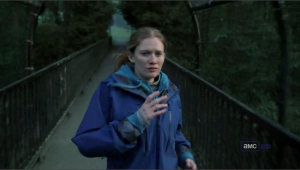
Perfectly normal.
It’s a tranquil scene. Sure, the POV moves along at a sprinting clip – pity the Steadicam operator who had to keep up with her – but the background is lush greens and blues. Besides, Linden’s face is center frame throughout. She’s a steady, calming presence.
Unlike …
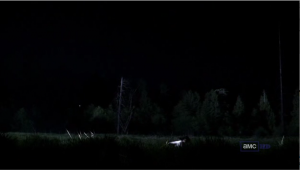
Also normal, within context.
… this screaming teenage girl, sprinting through an overgrown field at night! The only light is a bobbing flashlight fifty yards behind her.
Not exactly peaceful, but not unsettling given the show we’re watching. It’s a police procedural. It’s a murder mystery. Hence, we need a murder. And what better way to humanize the victim – thus making the killer all the more monstrous – than by showing her final hours?
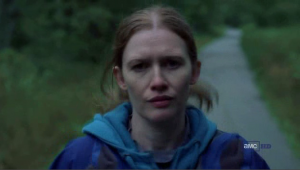
Oh, hey.
Back to Linden on her jog. Our perspective on Linden is straight ahead. She is coming right at us; in fact, her gaze meets the audience as the camera crosses frame. The road turns into a vanishing point behind her.
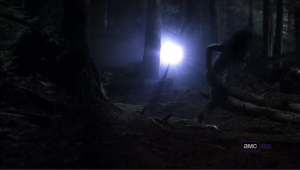
Contrast this with our victim, who crosses left to right both times. Linden’s face is clear and identifiable; the victim’s face is shadowed and indistinct.
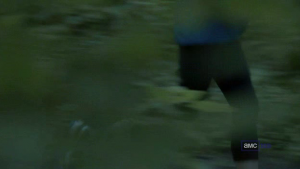
But now Linden’s running left to right, too. And in the next shot, our victim’s face is clear, while Linden’s obscured from the hips up.
These match cuts have gone on long enough for us to start wondering about the relation between these two. Is Linden flashing back to the night before? Is she reconstructing a chase scene in her head? Perhaps the young girl and Linden are the same and this is a nightmare from her past (a la Agent Clarice Starling in Silence of the Lambs). Whatever the case, we know there’s a connection.
Our victim gets a moment to rest: catching her breath behind a tree, biting at her fingers in terror, until the bobbing flashlight tells her that her pursuer is nearby. Linden keeps running throughout.
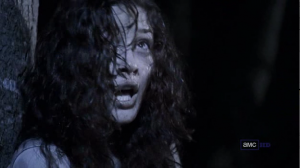
Back and forth, on and on, the music building and pounding throughout, until both Linden and the victim come to the bottom of the hill. We lose the victim at this point – literally – but stay on Larsen. In the distance, on the shore, she sees something.
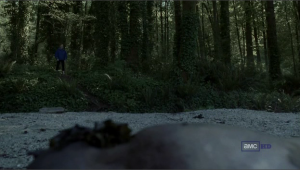
The moment we've been waiting for!
It’s so close in frame that we can’t focus on it. But it’s gray, bloated and irregular. It doesn’t look pleasant. And the full stop that Linden gives it, plus the hesitant approach, tells us it has to be a dead body.
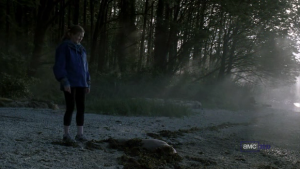
Do we get hand over mouth? Disgusted wince? Veteran cop steely gaze? What's it gonna be?
Because we all know what it is. The language of film has been telling us what it is for the last minute and a half. We’ve followed the victim through the fields, into the woods and down the hill to the shore. And we’ve followed Linden all that way as well. Now the victim’s path crosses with our hero’s. And so begins a twisted tale of murder and betrayal that will lead Sarah Linden to …
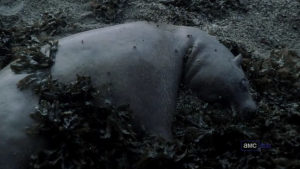
Mrurr?
Oh, wait, it’s a dog.
Roll credits.
Regarding the Steadicam bit: I’d be willing to put a dollar on the guy being on a Segway, like this Eurovision bit: http://www.youtube.com/watch?v=3f3mUs7rS1I
Day-amn! That’s some fancy footwork!
The Steadicam has always fascinated me. A Steadicam + Segway just blows my mind.
Not just that, though; pity the poor focus guy who had to keep up on foot!
The fakeout crime scene/going away party scene felt off to me as regards the rest of the script’s intelligent twisting of tropes. It came off as too much of ‘he was just one week away from retirement’ for me. That said, I agree that this is a very strong pilot and series thus far (4 episodes in). I give the pilot 9 out of 10 as a result.
I have a very high regard for the pilot episode of Veronica Mars. It succeeds in establishing the many principal characters (and there is no character drift throughout season one) and the overall story arc that ran the entire season. Veronica was a high school girl the likes of which hadn’t been shown on TV (at least not American TV). She was worldly and still young girl-ish.
Regarding character drift I mentioned above, pilot episodes are fascinating to compare to regular season episodes. While a flawed pilot can still produce a good series, a well executed pilot is almost certain to do so. Go back and watch the pilot of The West Wing and I think you’ll agree the only character nailed by the actor was Toby Zeigler (Richard Schiff). Everyone else to varying degrees didn’t understand their character yet (which could well be that Sorkin didn’t yet know them).
The Killing is very good TV, and has already become a show to which I look forward. As to the look, it reminds me of how well Wallander is shot. Both are atypical for series television.
Patrick
I didn’t have time to add Wallander to my list of shows to watch when it first came out, but The Killing has definitely made me want to check it out again. However, the time dilemma is still pretty much the same. :-P
I don’t know if you watched the TV series “Murder One”, but the first season is pretty good – one season, one case, from the litigation perspective. It really did get to delve further into everyone’s lives.
Plus – it’s got Stanley Tucci in it, playing a pretty good sleazeball.
Also, Patricia Clarkson chopped A LOT of vegetables!
Patrick
Great critique – makes a lot of sense! But are you perhaps giving Sud a little too much credit? I haven’t seen the American version, but I have seen the Danish original and it sounds from your description like it’s pretty much a carbon copy of that. Maybe Sud should be praised for not changing it, but I don’t think they are her original ideas …
@Perich: Good critique/review! I’m going to present your observations as my own.
@Zoe: The Killing/Sud is just following a trend in the business. There are a lot of examples of non-english scripts being run thru google translate and then being slapped with the name of a new writer. Examples that immediatly come to mind are Let me in and The next three days.
It’s propably not done in malevolance. It’s maybe a manifestation of somekind of cultural protectionism.
Anyways, the credit hoarding for translating and script doctoring is not helping in building the appreciation that the craft of writing deserves. Methinks…
Great break down, I love the series too. Minor quibble (and the sort of meaningless minutia that is only worth mentioning on a site called Overthinkingit) but Sonoma is in Northern, not Southern California. That stuff matters a great deal to us San Francisccans